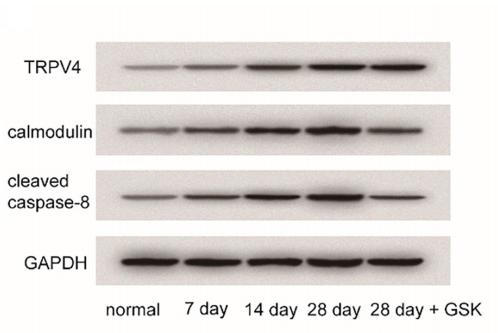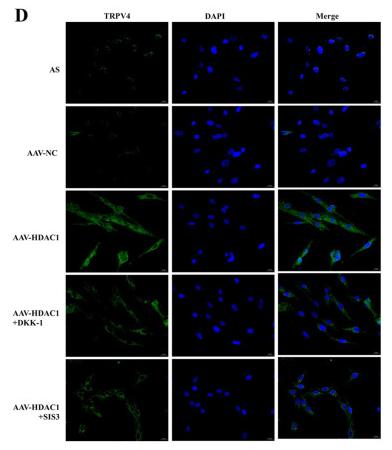TRPV4 Antibody - #DF8624
| Product: | TRPV4 Antibody |
| Catalog: | DF8624 |
| Description: | Rabbit polyclonal antibody to TRPV4 |
| Application: | WB IHC IF/ICC |
| Cited expt.: | WB, IF/ICC |
| Reactivity: | Human, Mouse, Rat |
| Prediction: | Pig, Zebrafish, Bovine, Sheep, Rabbit |
| Mol.Wt.: | 98 kDa; 98kD(Calculated). |
| Uniprot: | Q9HBA0 |
| RRID: | AB_2841828 |
Related Downloads
Protocols
Product Info
*The optimal dilutions should be determined by the end user. For optimal experimental results, antibody reuse is not recommended.
*Tips:
WB: For western blot detection of denatured protein samples. IHC: For immunohistochemical detection of paraffin sections (IHC-p) or frozen sections (IHC-f) of tissue samples. IF/ICC: For immunofluorescence detection of cell samples. ELISA(peptide): For ELISA detection of antigenic peptide.
Cite Format: Affinity Biosciences Cat# DF8624, RRID:AB_2841828.
Fold/Unfold
BCYM3; CMT2C; HMSN2C; osm 9 like TRP channel 4; Osm-9-like TRP channel 4; OSM9 like transient receptor potential channel 4; Osmosensitive transient receptor potential channel 4; OTRPC 4; OTRPC4; SMAL; SPSMA; SSQTL1; Transient receptor potential cation channel subfamily V member 4; Transient receptor potential protein 12; TRP 12; TRP12; TRPV 4; TrpV4; TRPV4_HUMAN; Vanilloid receptor like channel 2; Vanilloid receptor like protein 2; Vanilloid receptor related osmotically activated channel; Vanilloid receptor-like channel 2; Vanilloid receptor-like protein 2; Vanilloid receptor-related osmotically-activated channel; VR 4; VR OAC; VR-OAC; VR4; VRL 2; VRL-2; VRL2; VROAC;
Immunogens
A synthesized peptide derived from human TRPV4, corresponding to a region within C-terminal amino acids.
Found in the synoviocytes from patients with (RA) and without (CTR) rheumatoid arthritis (at protein level).
- Q9HBA0 TRPV4_HUMAN:
- Protein BLAST With
- NCBI/
- ExPASy/
- Uniprot
MADSSEGPRAGPGEVAELPGDESGTPGGEAFPLSSLANLFEGEDGSLSPSPADASRPAGPGDGRPNLRMKFQGAFRKGVPNPIDLLESTLYESSVVPGPKKAPMDSLFDYGTYRHHSSDNKRWRKKIIEKQPQSPKAPAPQPPPILKVFNRPILFDIVSRGSTADLDGLLPFLLTHKKRLTDEEFREPSTGKTCLPKALLNLSNGRNDTIPVLLDIAERTGNMREFINSPFRDIYYRGQTALHIAIERRCKHYVELLVAQGADVHAQARGRFFQPKDEGGYFYFGELPLSLAACTNQPHIVNYLTENPHKKADMRRQDSRGNTVLHALVAIADNTRENTKFVTKMYDLLLLKCARLFPDSNLEAVLNNDGLSPLMMAAKTGKIGIFQHIIRREVTDEDTRHLSRKFKDWAYGPVYSSLYDLSSLDTCGEEASVLEILVYNSKIENRHEMLAVEPINELLRDKWRKFGAVSFYINVVSYLCAMVIFTLTAYYQPLEGTPPYPYRTTVDYLRLAGEVITLFTGVLFFFTNIKDLFMKKCPGVNSLFIDGSFQLLYFIYSVLVIVSAALYLAGIEAYLAVMVFALVLGWMNALYFTRGLKLTGTYSIMIQKILFKDLFRFLLVYLLFMIGYASALVSLLNPCANMKVCNEDQTNCTVPTYPSCRDSETFSTFLLDLFKLTIGMGDLEMLSSTKYPVVFIILLVTYIILTFVLLLNMLIALMGETVGQVSKESKHIWKLQWATTILDIERSFPVFLRKAFRSGEMVTVGKSSDGTPDRRWCFRVDEVNWSHWNQNLGIINEDPGKNETYQYYGFSHTVGRLRRDRWSSVVPRVVELNKNSNPDEVVVPLDSMGNPRCDGHQQGYPRKWRTDDAPL
Predictions
Score>80(red) has high confidence and is suggested to be used for WB detection. *The prediction model is mainly based on the alignment of immunogen sequences, the results are for reference only, not as the basis of quality assurance.
High(score>80) Medium(80>score>50) Low(score<50) No confidence
Research Backgrounds
Non-selective calcium permeant cation channel involved in osmotic sensitivity and mechanosensitivity. Activation by exposure to hypotonicity within the physiological range exhibits an outward rectification. Also activated by heat, low pH, citrate and phorbol esters. Increase of intracellular Ca(2+) potentiates currents. Channel activity seems to be regulated by a calmodulin-dependent mechanism with a negative feedback mechanism. Promotes cell-cell junction formation in skin keratinocytes and plays an important role in the formation and/or maintenance of functional intercellular barriers (By similarity). Acts as a regulator of intracellular Ca(2+) in synoviocytes. Plays an obligatory role as a molecular component in the nonselective cation channel activation induced by 4-alpha-phorbol 12,13-didecanoate and hypotonic stimulation in synoviocytes and also regulates production of IL-8. Together with PKD2, forms mechano- and thermosensitive channels in cilium. Negatively regulates expression of PPARGC1A, UCP1, oxidative metabolism and respiration in adipocytes (By similarity). Regulates expression of chemokines and cytokines related to proinflammatory pathway in adipocytes (By similarity). Together with AQP5, controls regulatory volume decrease in salivary epithelial cells (By similarity). Required for normal development and maintenance of bone and cartilage.
Non-selective calcium permeant cation channel involved in osmotic sensitivity and mechanosensitivity. Activation by exposure to hypotonicity within the physiological range exhibits an outward rectification. Also activated by phorbol esters. Has the same channel activity as isoform 1, and is activated by the same stimuli.
Lacks channel activity, due to impaired oligomerization and intracellular retention.
Lacks channel activity, due to impaired oligomerization and intracellular retention.
Lacks channel activity, due to impaired oligomerization and intracellular retention.
N-glycosylated.
Apical cell membrane>Multi-pass membrane protein. Cell junction>Adherens junction. Cell projection>Cilium.
Note: Assembly of the putative homotetramer occurs primarily in the endoplasmic reticulum.
Cell membrane.
Cell membrane.
Endoplasmic reticulum.
Endoplasmic reticulum.
Endoplasmic reticulum.
Found in the synoviocytes from patients with (RA) and without (CTR) rheumatoid arthritis (at protein level).
The ANK repeat region mediates interaction with Ca(2+)-calmodulin and ATP binding (By similarity). The ANK repeat region mediates interaction with phosphatidylinositol-4,5-bisphosphate and related phosphatidylinositides (PubMed:25256292).
Belongs to the transient receptor (TC 1.A.4) family. TrpV subfamily. TRPV4 sub-subfamily.
Research Fields
· Cellular Processes > Cell growth and death > Cellular senescence. (View pathway)
· Organismal Systems > Sensory system > Inflammatory mediator regulation of TRP channels. (View pathway)
References
Application: WB Species: Human Sample:
Application: WB Species: Rat Sample:
Application: IF/ICC Species: Rat Sample:
Application: WB Species: rat Sample: articular cartilage
Restrictive clause
Affinity Biosciences tests all products strictly. Citations are provided as a resource for additional applications that have not been validated by Affinity Biosciences. Please choose the appropriate format for each application and consult Materials and Methods sections for additional details about the use of any product in these publications.
For Research Use Only.
Not for use in diagnostic or therapeutic procedures. Not for resale. Not for distribution without written consent. Affinity Biosciences will not be held responsible for patent infringement or other violations that may occur with the use of our products. Affinity Biosciences, Affinity Biosciences Logo and all other trademarks are the property of Affinity Biosciences LTD.










